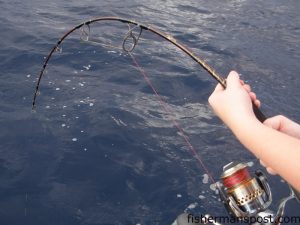Star Plasma Jigging Rods

Capt. Arlen Ash shows off the power of the basalt-reinforced fighting section of a spinning version of the Star Plasma Jigging rods.
Simply stated, these rods are the ultimate in jigging tackle on the American market, hands down. I have personally been avidly freestyle jigging for six years, and throughout this period of time it has been a constant struggle to find a jigging rod that is comfortable, durable, reduces strain/stress on the angler, and most importantly tames large gamefish.
This tackle exists. However, paying $500-1200 for a Japanese product with little to no warranty is hard to justify for most US anglers.
Star Rods’ new Plasma Jigging Rods are the answer. All come equipped with aluminum gimbals, properly spaced grips, Fuji SiC concept guides, a 5’2” length, and a warranty that consumers can trust.
The blanks have zoned actions: a primarily high modulus graphite tip for working/retrieving the jig, and a basalt-reinforced fighting section towards the butt. Retailing for $300-$330, the rods cost less than half of many of the Japanese models.
Some anglers may be asking themselves why these rods seem a bit pricy compared to crossover rods like the Shimano Trevala and Star Paraflex series, and the answer lies in a host of factors that make the Plasma series a superior fish-fighting and jig-working tool.
One of the most noticeable differences between the Plasma series and crossover rods is their length. Jigging rods never truly need to be longer than 5’4”. Extra length hurts the angler, both while jigging and when fighting a fish. Much leverage is gained with a 5’2” or shorter rod. Imagine holding a 10 lb. weight in hand with arms extended versus holding it at the end of a two-foot stick. These short, parabolic rods bring the load/strain directly to your hands.
Crossover rods are made longer to be more versatile for other applications, such as casting/pitching and trolling. US rod makers didn’t forecast the popularity of this fishing style in the states and, therefore, have not introduced a truly high-end jigging rod until now.
The Plasma series’ and crossover rods’ actions differ as well, although both are ultimately parabolic (bending evenly along their length). Crossover rods achieve this action because they are one material with a consistent taper. There is no tip section; therefore, the rod bends evenly when jigged, if at all. This means the angler is working the jig instead of the rod,which can grow tiresome quickly.
Plasma jigging rods have a tip section that loads and unloads with each jigging motion, reducing the stress/strain on the angler. This also propels the jig and allows the lure to achieve more action and flutter during the retrieve. When a fish is hooked, the tip section becomes null, and the entire rod goes parabolic.
The Plasma rods’ spacing and setup are also precisely tailored to their jigging task. All of these rods have elongated, ergonomically tapered rear grips, allowing for more comfort under the arm while jigging, and a 16.5” length that allows an angler to keep their arms extended during the fight to reduce fatigue.
The shortened foregrip gives the angler enough room for grip, but reduces line cuts and marks. The first guide is reversed to allow the line to follow the parabolic bend of the rod more closely and to reduce line stress on the stripper guide. It also protects the foregrip on conventional models.
The differences between the Star Plasma and crossover rods may be hard to understand and interpret if one has not avidly jigged or used this higher-end specialized tackle. A great way to display these differences is to perform lift tests with weights. Lifting 10 lbs. with the Plasmas and doing the same with the crossover style rods will immediately show the difference, both in the actions of the rods and the amount of strain on the angler. The 400 gram Plasma will lift 30+ lbs. with no trouble, seriously.
Having used over 30 different kinds of jigging rods, ranging from $150-$1200, I would instantly reach for these Plasmas time and again. They will land your fish of a lifetime repeatedly without question.
